How To Install A Driven Point Well
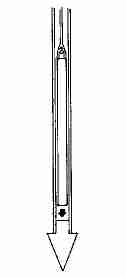 Driven Point Wells used for Drinking H2o
Driven Point Wells used for Drinking H2o
Driven Signal Small-Diameter H2o Well Installation, Diagnosis & Repair
- POST a QUESTION or Comment about driven point wells and jetted wells: diagnosis and repair
InspectAPedia tolerates no conflicts of interest. We have no human relationship with advertisers, products, or services discussed at this website.
Driven point well structure, capacities, troubleshooting & repairs:
Here we define driven point wells & depict how a driven point water well is constructed. We discuss why water flow and pressure are ultimately lost from a driven point well and nosotros explain how to restore water flow (sometimes) without having to construct a new well.
This article series explains installing, diagnosing, and repairing small diameter water wells including driven point wells, wash wells, and jetted wells, three types of h2o sources that may exist used where water is close to the ground surface and a well pipe or point can exist driven into the soil mechanically or past using hydrojetting.
We include an excellent UN FAO modest bore well certificate reference that will be helpful to those needing to construct a water well in areas where water is close to the ground surface and money or other resources are limited.
We also provide an ARTICLE Alphabetize for this topic, or you can try the page top or bottom SEARCH BOX as a quick way to detect information you lot need.
Small Diameter Driven Point Wells, Components, Operation, Maintenance
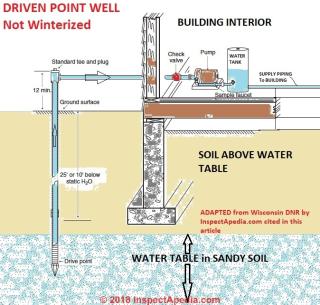 This commodity describes the two most mutual small-scale bore well methods, driven indicate wells and jetted wells.
This commodity describes the two most mutual small-scale bore well methods, driven indicate wells and jetted wells.
Other pocket-size bore well types include bored or augured wells, hydraulic percussion wells, cable tool percussion wells, bail down wells, and hydraulic rotary-drilled wells.
This commodity series describes various types of drinking water sources like wells, cisterns, dug wells, drilled wells, artesian wells and well and water pump equipment. We provide advice about what to do when things become incorrect.
Driven indicate wells consist of a thick-walled metal pipe whose finish is shaped into a point and drilled to permit water to enter the pipe.
The driven signal is and so hammered into the soil, usually to a very shallow depth, perchance 6' to viii' in depth, and unremarkably in sandy soil or in other soil where a lot of h2o flows easily to enter the finish of the piping.
Our sketch, adapted from the Wisconsin DNR cited below, shows a typical driven point well installation in an area where protection from freezing is not a business. ©InspectApedia.com
[Click to enlarge any epitome]
Besides see this DRIVEN POINT WELL FREEZE PROTECTION DRAWING [illustration] for a frost-protected sand point well installation, as well adapted from the Wisconsin DNR .
Definition of driven signal well
A driven-bespeak well – sometimes called a "sand indicate" – is a small diameter well fabricated by connecting lengths of 1-one/4" or 2" bore steel pipe together with threaded couplings. Threaded to the bottom of the string of pipe is a bulldoze-point well screen.
The screen is usually 2 to 3 anxiety long with a hardened steel tip or "drive-point" at the bottom. The purpose of the screen is to permit groundwater to flow into the well but go along the surrounding sand out. H2o can then be pumped up through the piping to the surface.
The hardened steel bulldoze-point tip allows the well to exist more easily driven into the ground. The pipage and drive-signal resemble a long spear.- Wisconsin Section of Natural Resources cited below.
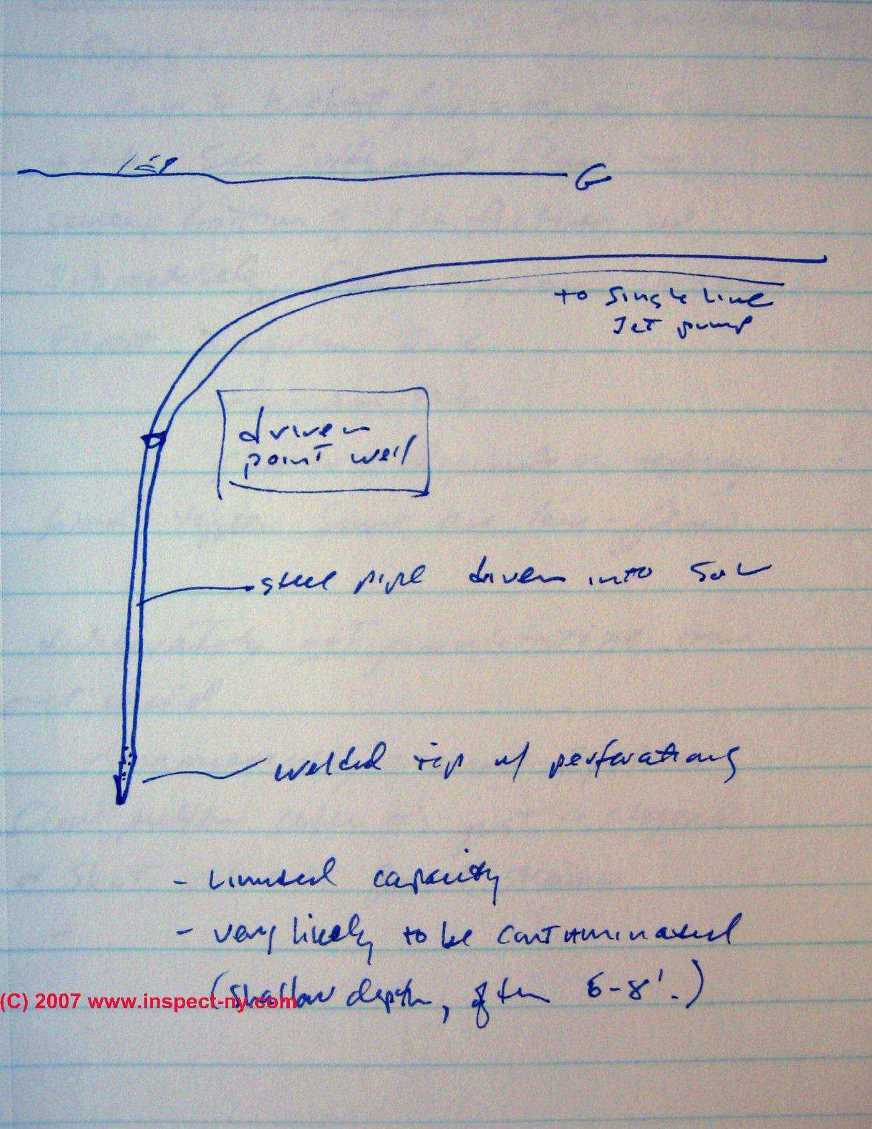 Readers of this document should also see Water TANK TYPES and before assuming that a water problem is due to the well itself, see WATER PUMP REPAIR GUIDE an specific case which offers an example of diagnosis of loss of h2o pressure, loss of h2o, and analyzes the actual repair toll.
Readers of this document should also see Water TANK TYPES and before assuming that a water problem is due to the well itself, see WATER PUMP REPAIR GUIDE an specific case which offers an example of diagnosis of loss of h2o pressure, loss of h2o, and analyzes the actual repair toll.
A variety of methods are used to install small-scale-bore water wells in areas where an adequate water supply is sufficiently close to the surface, where cost must be minimized, where well installation speed is of import, and where in that location may be less concern for drinking water contamination from surface runoff.
All of these small diameter well methods take the advantage of comparatively low cost, rapid installation, and simplicity. While a properly located and installed driven-betoken well can provide adequate and safety drinking water, the well is non without chance of both loss of water and contamination.
Watch out: all of these shallow, pocket-sized-diameter wells, constitute usually merely where soils are highly permeable and sandy, are tapping shallow groundwater where surface runoff contamination of the aquifer is probable: these wells are vulnerable to contamination from above. Well water from a driven betoken well or other shallow well should be regularly tested for potability.
See DRIVEN Indicate SAND POINT WELL CLEARANCE DISTANCES for setback distances for driven signal, sand betoken and other well types.
The maximum depth for driven point wells is about fourscore feet. If local soils are hard or rocky a driven well cannot be used.
The well indicate may exist purchased from a manufacturer (a forged well point) or hand made by cutting and hammering the end of the first pipage section. Holes to let water entry into the well pipe may exist drilled or sawn.
The pointed cease of the perforated pipe aids soil penetration and is further protected from soil entry into the pipe itself by a well screen. Additional perforations in the lower length of pipe increment the h2o intake of the arrangement.
Types of driven bespeak well screens: Equally the UN FAO document explains:
Well screens for driving must have sufficient force to withstand the forces caused by the commuter and the abrasion of the fabric through which they pass. One common type (Effigy 14a above) consists of a perforated drive pipe fitted with a point.
The perforated department of the pipe is wrapped with a layer of brass screen of the desired fineness and the screen is protected from damage past wrapping it with a layer of perforated brass canvas. Both layers are soldered to the pipe.
Another type of well screen (Figure 14b) is manufactured past wrapping trapezoidal rod in a spiral around a set of round longitudinal rods placed in a circular pattern with all intersections welded.
This blazon of screen has the advantage of having a loftier percent of open up area and a slot shape which cannot become wedged full of fine sand particles.
How are driven point wells installed?
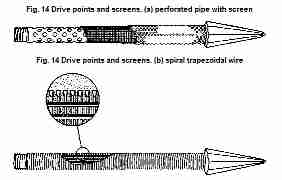 The driven point is then hammered into the soil, usually to a very shallow depth, perhaps vi' to viii' in depth, and usually in sandy soil or in other soil where a lot of h2o flows easily to enter the end of the piping.
The driven point is then hammered into the soil, usually to a very shallow depth, perhaps vi' to viii' in depth, and usually in sandy soil or in other soil where a lot of h2o flows easily to enter the end of the piping.
The sketch shows two types of driven point well tips or screens - from a small well article provided by the United Nations, FAO, cited below.
While special heavy-walled pipe and couplings are needed for the pipe to withstand the forces of being hammered into the ground (usually by a weight that is repeatedly lifted and dropped onto the upper pipage end), driven point wells are often dwelling house fabricated or made past a local well driller
The well pipe with attached indicate and screen is usually driven past a slide hammer much like those used to drive steel fence posts. A larger diameter pipage that volition slide over the upper terminate of the well pipe is raised and dropped repeatedly to bulldoze the well point into the soil.
A screw-on pipage cap protects the upper end of the driven well pipe from damage. Run across the Un FAO sketch of a well driving appliance (below left).
Alternatively the driving piping may slide inside the well pipe every bit shown in our second UN FAO drawing (below-right). Two additional well point driving schemes are included in the illustrations available in the full Un certificate
SMALL DIAMETER WELLS - Natural Resources Management & Environment Department, Nutrient and Agriculture Organisation of the United Nations, FAO Corporate Document Repository - Self-Help Wells.
That excellent resources includes other well ho-hum and drilling methods every bit well equally techniques for dealing with problems such as retrieving broken well pipes or tools dropped into a well. (Local re-create provided).
The upper cease of the driven point piping is usually connected to a one line jet pump which "sucks" water out of the ground.
In areas of very moisture sandy soil a driven indicate well may be able to produce a barely functional water supply quantity (by modern standards)
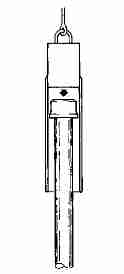
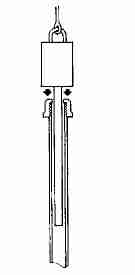
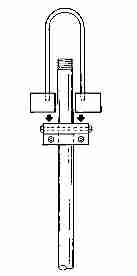

Well Water Quantity - Yield of Driven Point Wells
Driven point well water quantity - well yield capacity: Compared with a modernistic 6" steel casing drilled well, a driven betoken well installed to the same depth in an aquifer of the aforementioned yield capability (the cone of low is the aforementioned), a larger diameter well volition yield 1.6 times that of a small diameter well according to United nations documents on water wells.
Driven betoken wells often have rapid reduction in h2o flow charge per unit, depending on the type of soil into which the driven signal was inserted. For this reason multiple driven point wells may be continued together to obtain an adequate water supply.
If the water quality from a driven signal small-scale diameter well is acceptable only the water quantity is not, it may be possible to improve well yield by driving the betoken deeper into the soil. In general, well yield increases more by increasing well depth than by increasing the well bore.
Driven bespeak well sanitation and h2o quality: Fifty-fifty in areas of sandy soils where these shallow wells are oftentimes used, water quality is questionable as surface contaminants easily enter the water supply, and h2o quantity is unreliable in areas where the water passage holes in the driven bespeak become hands clogged with debris.
Our clients who have bought homes serviced by a driven point well accept ultimately converted to a modernistic drilled well for meliorate water quantity and for a more sanitary h2o supply.
Driven point wells are also used in soil de-watering applications during structure and in some locations driven point wells are used to test for water in soils earlier drilling or earthworks a higher capacity well.
Small Bore Jetted Wells or "Wash Wells"
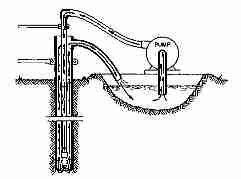 What is a wash well? Jetted wells are similar to driven point wells in that a pipe is forced into the soil and connected (near often) to a unmarried line jet pump. In some communities the term "wash well" is used for this water source, equally suggested past New Hampshire reader Jack Allen.
What is a wash well? Jetted wells are similar to driven point wells in that a pipe is forced into the soil and connected (near often) to a unmarried line jet pump. In some communities the term "wash well" is used for this water source, equally suggested past New Hampshire reader Jack Allen.
How are jetted wells or wash wells installed? In either case, the pipe that is to be used to obtain water is forced into the soil using h2o at high pressure (40 psi for sandy soils, upward to 150 psi for dirt or gravel) from an existing water source.
The illustration (left) is from UN document Modest DIAMETER WELLS [PDF]
Unlike a driven point well, however, the pipe used in combination with water to strength an opening into the ground (the jetting tube) may be a temporary i (the jetting casing is removed from the footing afterward the jetting process is complete, followed by the insertion of a new casing and casing cease screen) or it may be permanent (left in the ground at the terminate of the jetting process, jacked upwardly just plenty to accommodate a well screen lowered within the casing to its lesser end).
An culling jetted well process permits soil material to actually be removed from the well opening during the jetting procedure (soil flows up from the bottom of the jetting casing effectually its outside surface.
Water flowing from the tip of the jet dislocates soil sufficiently to permit the well pipage to be pushed into the ground. Using this process a jetted well (or wash well) may exist driven deeper into the soil than a driven point well, and a jetted well may be driven through soils harder than those penetrated past a driven point well.
Check valves or foot valves in jetted wells: To avoid losing prime in a jetted well a check valve may exist used at the lower terminate of the casing, above the well screen. This detail is of import for a homeowner to know, because if a jetted well or wash well stops working the problem could exist a failed check valve (or foot valve) rather than a loss of water in the aquifer.
Jetted well h2o chapters or well yield: In soils that contain large amounts of h2o, specially in areas of gravel or sand, a jetted well or wash well may deliver good water flow or quantity.
Jetted well h2o sanitation: Withal the water quality questions that employ to a driven indicate well might demand to exist considered for a jetted well too: a well of this pattern has little protection from unsanitary groundwater compared with a steel-casing drilled-well that is cut into h2o begetting rock and that is sealed against surface water entry.
Nosotros suspect that a jetted well installed using the alternative process that actually removes fabric from the well opening past flowing soil to the surface along the exterior of the well casing may be more prone to surface water leaking into the well and its aquifer.
Mr. Allen points out that when well repair or service is required for a jetted well, the homeowner volition need to contact a company who is familiar with this particular well type.
Driven Bespeak Well Construction References
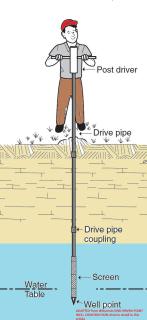
- DRIVEN Point (Sand-Betoken) WELLS, [PDF] Wisconsin Department of Natural Resource, PUB DG 022 2022 retrieved 2022/06/12, original source: https://dnr.wi.gov/files/PDF/pubs/DG/DG0022.pdf
Analogy shown here is adapted from this WI DNR document. [Click to enlarge any epitome]
- Small-scale DIAMETER WELLS [PDF] Natural Resources Management & Environs Department, Nutrient and Agriculture Organization of the Un, FAO Corporate Document Repository - Self-Aid Wells - see http://www.fao.org/docrep/X5567E/x5567e05.htm
This article also has has a nice department on well piping or dropped tool fishing tools
- WELL RETRIEVAL TOOLS.
If a tool is dropped into a well or if a department of well pipage becomes asunder and drops into a well, special devices can be lowered into the well to attempt to grasp or hook the lost object (or pipe) to pull it back out of the well. See http://world wide web.fao.org/docrep/X5567E/x5567e05.htm#four.eleven%20problem%20solving
This document describes the following types of pocket-sized-diameter (manus-built) water wells: [Quoting]
4.one Bored or augered wells -This method of excavation consists of shaving or cut material from the bottom of the hole past the rotation of a cylindrical tool with one or more cutting lips. The procedure is quite analogous to boring a hole in forest or metallic with an auger or drill.
The excavated earth normally feeds upward and is contained in the body of the auger where it remains until the auger is emptied.The auger is both rotated and raised and lowered by means of a vertical shaft which extends upwards from the auger to a convenient betoken higher up ground level from which it tin can exist rotated.
Rotation is frequently achieved by human ability applied to a handle attached to the vertical shaft.
However, the auger may be driven by other power sources such as animal or engine power. In this case, the power source drives a horizontal ring gear.
Two projections extending upward from the ring gear bulldoze a bar known equally a "kelly" which lies across a diameter of the ring.
A square section of the auger shaft fits through a square hole at the centre of the kelly bar which causes the auger shaft to rotate with the kelly bar while assuasive it vertical freedom.
four.2 Driven wells -The driven well consists of a pointed perforated piping or a pipe with a pointed well screen fastened which has been driven into an aquifer.
The pipe with pointed well screen is driven into place in much the same mode a nail is driven into wood. Normally special pipe with thick walls and specially designed couplings are used to resist the driving forces.
Under suitable atmospheric condition this method tin can yield a finished well in a very short time. While the well bore is normally modest and the yield relatively depression, a number of driven wells may be coupled together and pumped with a single pump.
Because driven wells are quick to construct, they may be used as a temporary source of water and then be pulled up when no longer needed. Driven well points may be installed and used for de watering an excavation during structure. Unlike other well construction methods, material is merely forced bated and not excavated by the driving process.
This means that little is learned nigh the material through which the well pipe passes. This kind of well can, however, exist used for exploratory purposes to determine static water level and charge per unit of inflow versus drawdown. Hard formations cannot be penetrated by this process.
Disallowment impermeable strata the depth to which such a well tin can be driven depends on the build-up of friction betwixt the well piping and the fabric penetrated and the transmission of the force of the commuter down the length of pipe. 20-5 to thirty metres (80-100 feet) would probably be a maximum.
A driven well point might be employed to finish a hole which had been excavated down to the h2o table by some other method such equally an auger.
four.3 Jetted wells -This method makes apply of a high velocity stream of h2o to excavate the hole and to carry the excavated material out of the hole.
It therefore requires some blazon of pump, either motor or hand-powered, of reasonable capacity, likewise as a supply of water.
It is possible to separate the water and the excavated fabric in a settling puddle or tank and to reuse the water, thus minimizing the quantity required.
Since this method depends on the erosive action of water, it is obvious that extremely hard materials cannot be penetrated.
However, semi-difficult materials may exist penetrated by a combination of hydraulic and percussion effects. This is accomplished by raising and dropping a chisel-edged jetting flake.
Coarse materials such as gravel require a greater water velocity to move them vertically out of the hole than do effectively materials.
However, very fine, difficult packed materials such as clays require a high h2o velocity to dislodge them. Water pressure level of 3 kg/cm2 (twoscore psi) for sand and seven-eleven kg/cm2 (11-150 psi) for clay or gravel have been recommended. Under good weather condition, drilling progress is very fast.
4.iv Hydraulic percussion (too hollow rod method) driven wells - In this method the hole is kept full of water and a combination of mechanical and hydraulic action practise the excavating (Figure 17). A chisel-edged cutting chip is attached to the lesser of a string of drill pipe. The hollow bit has inlet ports a minor distance above its cut edge.During drilling the drill pipage is alternately raised and dropped.
Pressure due to the impact of the cutting flake in the bottom of the pigsty and the inertia of the h2o cause a mixture of h2o and cuttings to enter the inlet ports of the cutting bit. This causes the already full drill pipage to overflow. A bank check valve in the cut bit prevents the mixture of water and cuttings from flowing out of the ports when the drill stem is raised.
The cuttings may exist settled out from the water in a pool or barrel later on the mixture overflows from the drill pipe and the water can so exist recycled. Hydraulic percussion is limited to drilling through relatively fine materials, since coarse materials will not rise to the surface through the drill piping.
This method has been used to depths of more than 900 metres (iii 000 feet) in alluvial areas where neither difficult formations nor coarse materials were encountered.
iv.v Percussion Wells(as well cablevision tool method) driven wells - This method consists of repeatedly raising and dropping a chisel-edged bit to break loose and pulverize cloth from the bottom of the hole. A small amount of water is kept in the hole, and then that the excavated textile volition be mixed with it to course a slurry.
Periodically the percussion bit is removed, and a bailer is lowered to remove the slurry containing the excavated material. The bailer or bailing saucepan consists of a tube with a check valve at the bottom and a bail for attaching a cable or rope to the top.
When information technology has been raised and dropped a number of times to fill up it with the slurry it is brought to the surface for elimination.
Bailing is repeated until the pigsty has been adequately cleaned, at which time drilling is resumed; drilling and bailing are so alternated. If the pigsty is unstable, casing is lowered and the driving of casing is alternated with the other two processes.
In loose granular material, such as sand, bailing solitary may be sufficient to remove the material from the lesser of the hole and allow the casing to exist sunk.
A heavy bailer with a cutting border at its lower finish, known as a "mud scow" is used for this purpose.
4.6 Hydraulic rotary drilled wells - This method employs a drilling bit at the bottom of a stem of rotating drill pipage. Cuttings are removed by pumping water or a mixture of water and various clays down through the drill stem. This "mud" entrains the cuttings and carries them upwards through the annular space between the drill pipe and the wall of the hole.When they reach ground level, the cuttings can be settled out in a small swimming and the "mud" re circulated. If the reverse menses path is used ("mud" pumped to the surface through the hollow drill pipe) the system is called reverse rotary.
The reverse rotary organisation allows larger particles of cuttings to exist brought to the surface, because the upward menses velocity inside the pipe is greater than that through the annular space, due to the smaller catamenia cross section inside the piping.
- Cheers to reader Lloyd McVey at AKR for discussing using compressed air to restore water flow in a driven point well, July 2022
- Admission H2o Free energy, PO Box 2061, Moorabbin, VIC 3189, Australia, Tel: 1300 797 758, email: sales@accesswater.com.au Moorabbin Office: Kingston Trade Centre, 100 Cochranes Rd, Moorabbin, VIC 3189 Website: http://www.accesswater.com.au/
Australian supplier of: Greywater systems, Solar ability to grid packages, Edwards solar systems, Vulcan compact solar systems, water & solar system pumps & controls, and a wide rage of in a higher place basis & under ground water storage tanks: concrete, steel, plastic, modular, and bladder storage tanks.
- JETTED WELLS
- SMART TANK, INSTALLATION INSTRUCTIONS [PDF] - , Flexcon Industries, 300 Pond St., Randolph MA 02368, www.flexconind.com, Tel: 800-527-0030 - web search 07/24/2010, original source: http://www.flexconind.com/pdf/st_install.pdf
- TYPICAL SHALLOW WELL ONE LINE JET PUMP INSTALLATION [PDF] - , Grove Electric, G&G Electric & Plumbing, 1900 NE 78th St., Suite 101, Vancouver WA 98665 world wide web.grovelectric.com - web search -7/15/2010 original source: http://www.groverelectric.com/howto/38_Typical%20Jet%20Pump%20Installation.pdf
- TYPICAL DEEP WELL Ii LINE JET PUMP INSTALLATION [ PDF ] - , Grove Electric, G&G Electric & Plumbing, 1900 NE 78th St., Suite 101, Vancouver WA 98665 world wide web.grovelectric.com - web search -7/15/2010 original source: http://www.groverelectric.com/howto/38_Typical%20Jet%20Pump%20Installation.pdf
- Wash WELLS
- WATER FACT SHEET t #3, USING Low YIELD WELLS [PDF] - , Penn Country Higher of Agricultural Sciences, Cooperative Extension, Schoolhouse of Forest Resource, web search 07/24/2010, original source: http://pubs.cas.psu.edu/FreePubs/pdfs/XH0002.pdf
Restoring the Yield of a Driven Point Well - how can I become my water back?
This topic has moved to DRIVEN Indicate WELL RESTORATION.
Reader Q&A - as well see the FAQs series linked-to below
Anon
Certainly if yours is a driven point well, you have to check that blazon. A dug well would be entirely different.
If there are other questions that merely pertain to multiple-users on a unmarried well, I'd leave those blank.
Cheque with your edifice department to enquire what they await.
on my Building Permit information technology asks if my well id dug or driven. The driven well questions that follow are indicative of a multiple useage-we just have the one home. What should I put downwardly?
LC I think that means that
The volume of water you're pouring into the driven point pipe is less than the volume over the length of the pipe,
or
at that place is a serious leak underground somewhere in the pipe into which you are pouring water
or
the well is dry out and but taking all the water back that it can go.
LC I recall that means that either the volume of water you're pouring into the driven point pipe is less than the book over the length of the piping, or the well is dry out and just taking all the water dorsum that information technology tin can get.
Subsequently washing a sand point to xx anxiety, nosotros filled the pipe with h2o and the water goes down like a drain. What does that mean?
Encounter
http://inspectapedia.com/water/Driven_Point_Well_Restoration.php
I have drive my one 1/4 point down 23' having 6' of water . my signal upon flushing filled with h2o . I was told to try flushing longer while trying to turn the pipage . the pipe would not plow . it did drain , but will fill up . I hooked upwards my pump and I'm only receiving approximately 2 gal of water / infinitesimal . I've run for an 60 minutes shot it off for an hour restarted and it has kept its prime . I'chiliad running again at present hoping it improves . what is my next step ?
With h2o turned off into the building and the pump turned off y'all volition run across system pressure level continue to autumn if at that place is a leak
How do I check for a leaking pipe connection. ?
...
Continue reading at DRIVEN Bespeak WELL RESTORATION or select a topic from the closely-related articles below, or see the complete Commodity Index.
Or come across DRIVEN POINT WELL FAQs - questions & answers nigh small-scale diameter driven point wells posted originally on this folio.
Or see these
Recommended Articles
- DRIVEN Betoken WELLS - dwelling house
- DRIVEN POINT WELL RESTORATION
- DRIVEN POINT SANDPOINT WELL CHLORINATION
- IRON & SEDIMENT REMOVAL
- JETTED WELLS
- OLD WELL - RETURN TO SERVICE
- WASH WELLS
- Water Treatment EQUIPMENT CHOICES
- WELL FLOW Charge per unit
- WELL LIFE EXPECTANCY
Suggested citation for this spider web folio
DRIVEN Indicate WELLS at InspectApedia.com - online encyclopedia of edifice & environmental inspection, testing, diagnosis, repair, & problem prevention advice.
Or see this
Alphabetize to RELATED Manufactures: Commodity INDEX to WATER SUPPLY, PUMPS TANKS WELLS
Or use the SEARCH BOX establish beneath to Ask a Question or Search InspectApedia
...
Ask a Question or Search InspectApedia
Try the search box simply below, or if you lot prefer, post a question or comment in the Comments box below and we will respond promptly.
Search the InspectApedia website
Notation: appearance of your Comment below may exist delayed: if your comment contains an image, spider web link, or text that looks to the software as if it might be a web link, your posting volition appear after it has been canonical by a moderator. Apologies for the delay.
Technical Reviewers & References
Click to Show or Hibernate Citations & References
Publisher InspectApedia.com - Daniel Friedman
Source: https://inspectapedia.com/water/Driven_Point_Wells.php
Posted by: andersonthumbeth1938.blogspot.com


0 Response to "How To Install A Driven Point Well"
Post a Comment